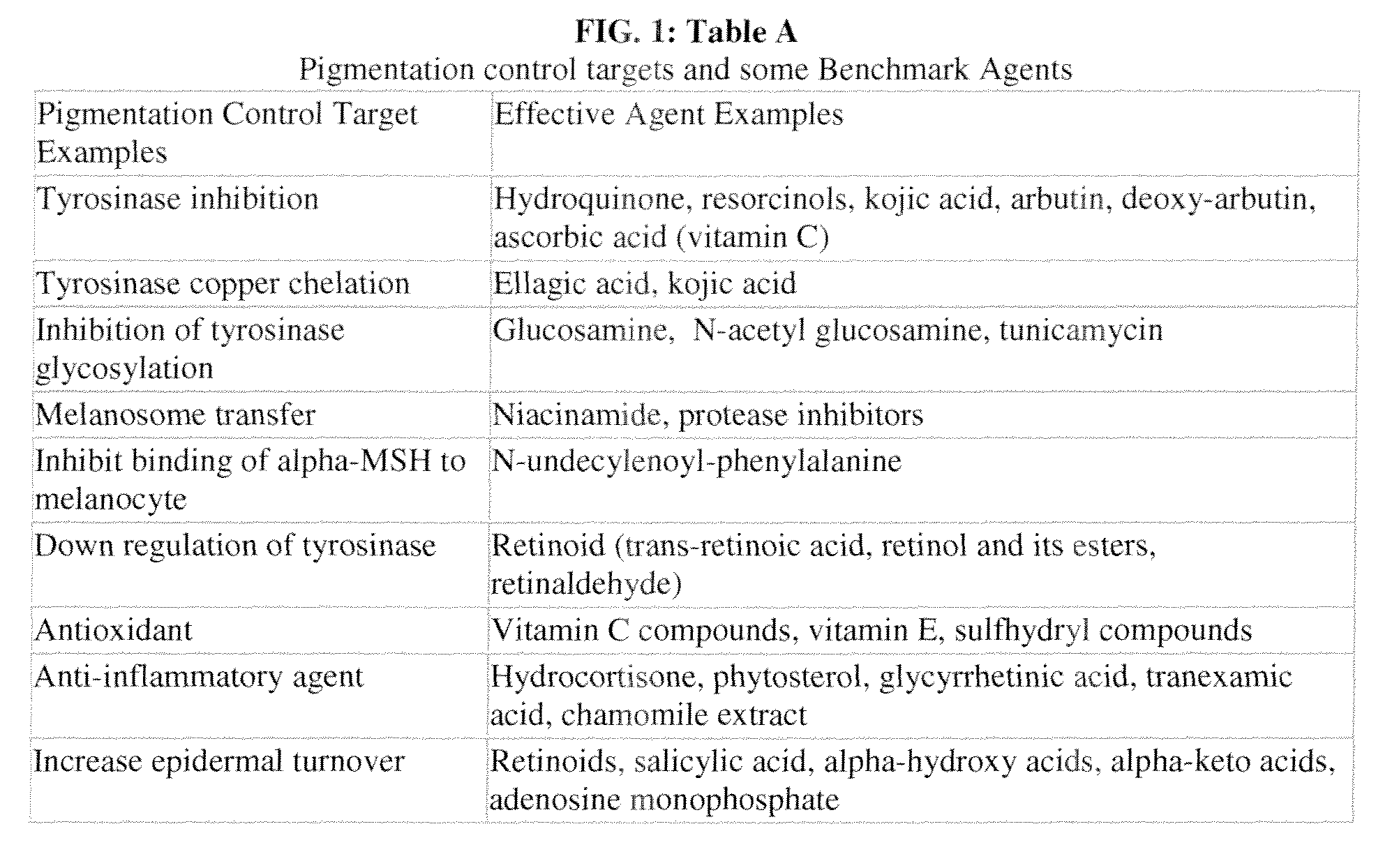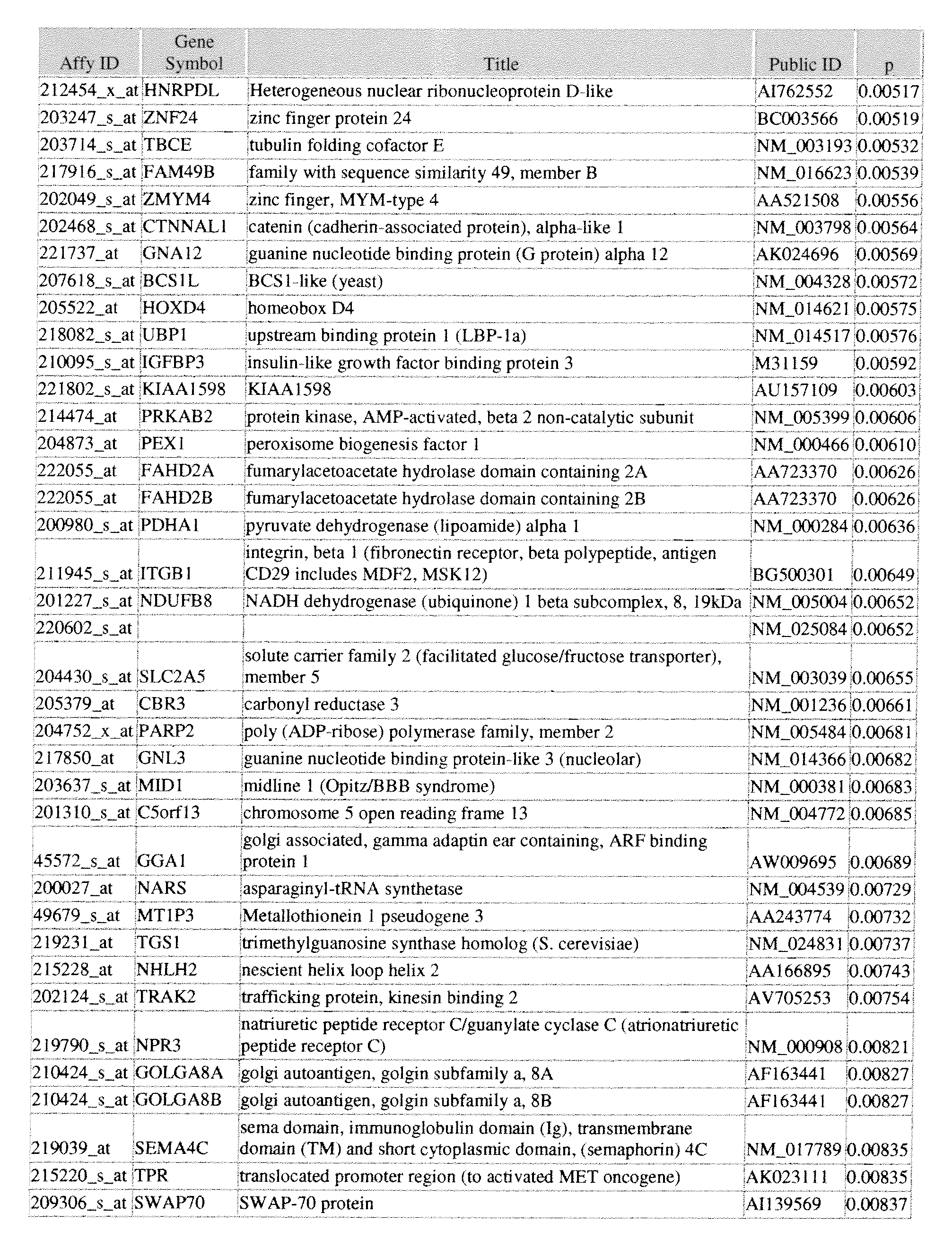Method of Generating a Hyperpigmentation Condition Gene Expression Signature
a technology of gene expression and hyperpigmentation condition, which is applied in the field of generating the gene expression signature of hyperpigmentation condition, can solve the problems of maintaining undesirable contrast, reducing the effect of topical interventions and formulations, and reducing the effect of aging
- Summary
- Abstract
- Description
- Claims
- Application Information
AI Technical Summary
Benefits of technology
Problems solved by technology
Method used
Image
Examples
example 1
[0170]This Example illustrates use of C-map to identify connections between perturbens and genes associated with a pigmentation condition, wherein the pigmentation condition is a hyperpigmentation condition. Specifically an analysis of tissue from the arms of individuals showing the hyperpigmentation condition Solar Lentigines (age spots) is compared to an analysis of tissue from full normal controls, and an expression signature is created as herein described through specific statistical comparisons, filtering, and sorting. The expression signature can then be used to implement a data architecture by providing a C-map query to identify relationships between perturbens and genes associated with a hyperpigmentation pigmentation condition.
Deriving a Hyperpigmentation Condition Expression Signature
[0171]RNA isolated from clinical samples was analyzed using the Affymetrix HG-U133 Plus 2.0 GeneChips, which contain 54,613 probe sets complementary to the transcripts of more than 20,000 gene...
example 2
[0178]This Example provides support for the use of benchmark signatures in a C-map query to generate putative agents. The Example specifically outlines generation of a benchmark skin pigmentation-modifying gene expression signature. As described herein, the benchmark skin pigmentation-modifying gene expression signature was generated using methods such as filtering as described in Example 1. More specifically, Hexamidine, N-acetyl glucosamine, Niacinamide, or SEPIWHITE (Sepiwhite is the purported tradename of the agent known as undecylenoyl phenylalanine) are applied as described below to tert-Keratinocyte cells to generate the benchmark skin pigmentation-modifying gene expression signature.
[0179]A. Hexamidine (hex).
[0180]A tert-Keratinocyte (tKC) cell line is used to conduct the genomics study with an Affy U133A chip. (a) Probe selection method for up-regulated probes: 1. mean expression value of hex treated>200, 2. ratio of present calls of hex treated chips>=50%, 3. up regulated ...
example 3
[0187]This Example illustrates use of C-map and the generation of a signature as described in Example 2; however Example 3 outlines development of a composite “skin tone” signature where Niacinaminde, Sepiwhite, NAG, and Hexamidine are used together to generate a signature. This Example illustrates generation of an exemplary composite “skin tone” Signature comprised of four benchmark skin-lightening agents: Niacinamide, Sepiwhite, NAG, and Hexamidine. Chips Used for Signature Generation: DMSO control chips used for Signature generation: Conditions for Signature Generation: 1. a probe must have 10% present call among Control chips or BenchMark chips, 2. The average signal for an up-regulated probe on the treated chip must be >200, 3. The average signal for a down-regulated probe on the control chip must be >200, 4. A probe must be up or down-regulated cross all benchmark chips. Table Headers: Average signal of all control chips, AvgFC, AvgSignalTreated: Average signal of all treated ...
PUM
| Property | Measurement | Unit |
|---|---|---|
| color | aaaaa | aaaaa |
| concentration | aaaaa | aaaaa |
| density | aaaaa | aaaaa |
Abstract
Description
Claims
Application Information
 Login to View More
Login to View More - R&D
- Intellectual Property
- Life Sciences
- Materials
- Tech Scout
- Unparalleled Data Quality
- Higher Quality Content
- 60% Fewer Hallucinations
Browse by: Latest US Patents, China's latest patents, Technical Efficacy Thesaurus, Application Domain, Technology Topic, Popular Technical Reports.
© 2025 PatSnap. All rights reserved.Legal|Privacy policy|Modern Slavery Act Transparency Statement|Sitemap|About US| Contact US: help@patsnap.com



